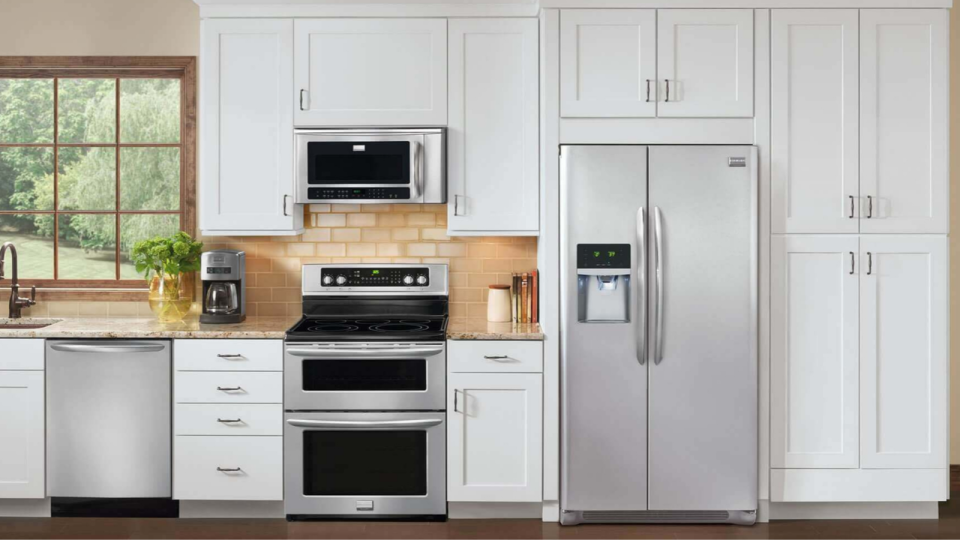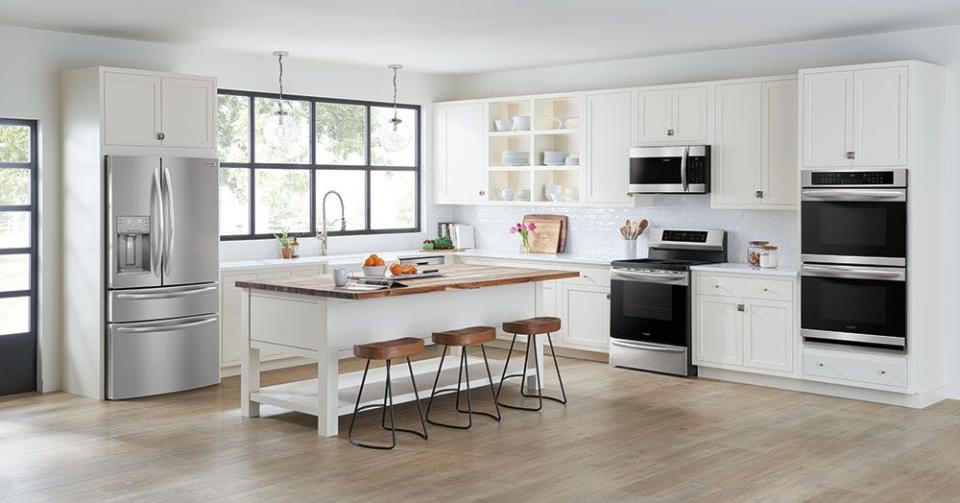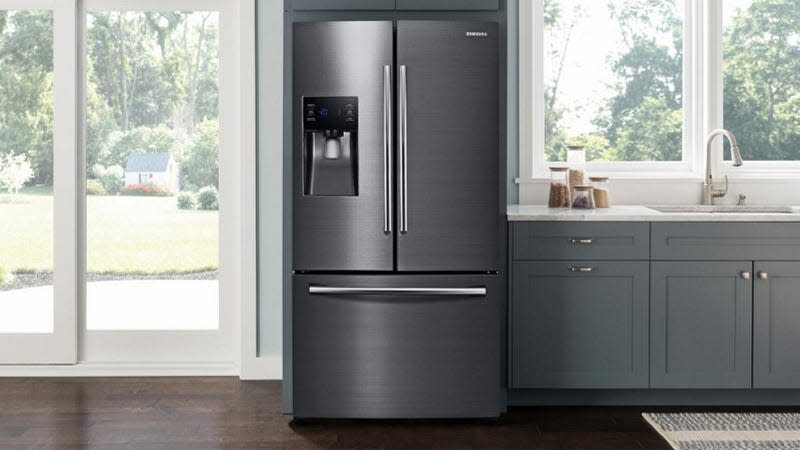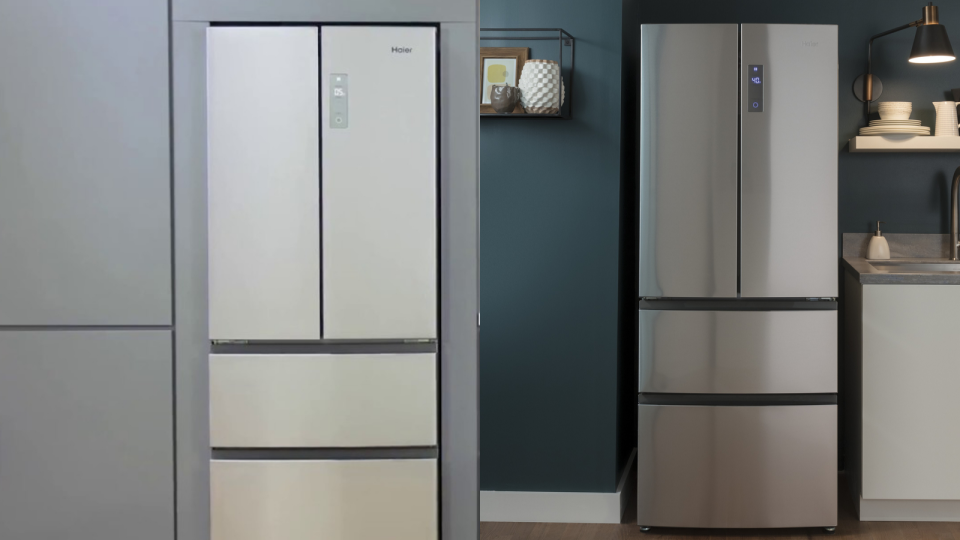The best refrigerators of 2020

— Recommendations are independently chosen by Reviewed’s editors. Purchases you make through our links may earn us a commission.
When you’re shopping for a fridge, a stroll through a home improvement store may overwhelm you with rows and rows of fridges that more or less look identical. It's easy to panic and just pick one at random, so you can escape before your eyes totally glass over.
This is where we come in. Here at Reviewed, our experts have tested hundreds of French-door, side-by-side, bottom freezer, and top freezer refrigerators in our labs, so we can help you make the best decision for your home.
Get expert shopping advice delivered to your phone. Sign up for text message alerts from the deal-hunting nerds at Reviewed.
We consider temperature consistency, storage capacity, and ease of use to be the most important aspects of a good fridge. Typically, the fridge with the best of everything costs a pretty penny.
Our favorite fridge is the Frigidaire Gallery FG4H2272UF (available at AppliancesConnection for $2,873.10), which is a good fit for those who have no budget or space concerns. This 21.8-cubic-foot behemoth offers top-notch temperature consistency (allowing you to preserve your food safely and effectively) and even has a drawer that can be converted into extra fridge or freezer space.
For those with a different budget, style, and feature preferences, we have plenty of other recommendations that will work in your kitchen and not give you sticker shock.
Here are the best refrigerators we've tested, ranked in order:
1. Frigidaire Gallery FG4H2272UF

The Frigidaire FG4H2272UF really has it all. In addition to easily maintaining cold temperatures during testing, this beautifully designed French-door fridge has so many storage options it'll blow your mind.
While most counter-depth fridges make you feel as though you had to give up storage space so that its shallower profile will fit in with your cabinetry, the FG4H2272UF makes every cubic foot of space count.
Not only does it have adjustable-width sliding bins on the door, the fridge itself has a retractable shelf, a pocket "snack zone" that lives just below the crisper (and allows easy access for the shorter humans in your life), and an entire fourth compartment that can be used as either additional fridge or freezer storage.
Get the Frigidaire FG4H2272UF at Appliances Connection for $2,873.10
2. Kenmore Elite 72483

In addition to sleek design, ergonomic layout, adjustable shelves, and excellent food preservation performance, the 29.9-cubic-foot Kenmore Elite 72483 adds a separate temperature-controlled center drawer for storing everything from snacks and deli meats to wine.
Though it has an external water and ice dispenser, the fridge hides all of its controls behind the door, which gives the 72483 a streamlined and contemporary look.
With a wide variety of additional storage options (including recessed pockets at the bottom of the fridge and multiple sliding drawers in the freezer), this is a great fridge for large families.
Get the Kenmore Elite 72483 at Sears for $2,699.99
3. GE Café CVE28DM5NS5

The GE Café CVE28DM5NS5 is a French-door refrigerator that doubles as a statement piece. With its shiny platinum glass finish, shelves with rose gold accents, and beautiful backlit LED wall in the fridge’s interior, you may start to think that this fridge emphasizes function over form—and you’d be wrong.
This fridge has spot-on temperature control, a highly effective crisper drawer, and a wide variety of flexible and adjustable storage options.
For those of you who spend a lot of time hosting parties, you’ll appreciate the extra temperature-controlled drawer (with both freezer and fridge settings) and the extra rack in the freezer that’s perfect for flat foods like pizzas.
Need help finding products? Sign up for our weekly newsletter. It’s free and brings our deals directly to your inbox.
Another great feature is Autofill, the water dispenser that automatically senses the height of your water vessel, fills it up without overflowing, and reports (in ounces) how much water was dispensed. Yes, this fridge costs three to four times what you’d pay for a more basic fridge, but if you have a big budget, you’ll appreciate its look and utility.
Get the GE Café CVE28DM5NS5 at Appliances Connection for $3,773
4. LG LSXS26366S

If you want a fridge that is capable of both high-quality food preservation and of being a conversation starter, look no further than the LG LSXS26366S three-door, side-by-side refrigerator.
With a press of a button, you can access the door-in-door storage on the upper right side of the fridge, which allows you to easily grab the items you need frequently without disrupting the cooling of the rest of the fridge. If you don't press the button, the fridge opens normally.
Between this very useful storage feature and food preservation that just won't quit, we'd highly recommend the LG LSXS26366S to anyone, especially if you're looking for a compromise between a side-by-side fridge and a French-door fridge.
Get the LG LSXS26366S at Appliances Connection for $1,795
5. Samsung RF263BEAESG

The Samsung RF263BEAESG French-door refrigerator is designed with a large family in mind. Not only does it have a fingerprint-resistant stainless steel finish, but its deep door bins have room for more than one gallon of milk.
Its adjustable shelving makes it easy to store tall or large items without losing a lot of existing fridge real estate.
If you’re worried about people constantly opening the fridge doors, the crispers have been designed so that you can open one by only opening one door, which cuts down on the cold air lost every time the refrigerator is opened.
In our tests, we found that the fridge temperatures run a little cool; you can bump up the temperature a bit, but make sure you check the temperature with a fridge thermometer so that you’re not getting too close to the bacteria danger zone (which starts at 40°F).
Otherwise, we are impressed with how well the crisper drawers maintained humidity, and how energy-efficient this fridge is.
Get the Samsung RF263BEAESG at Best Buy for $2,099.99
6. Samsung RF23J9011SR

The Samsung RF23J9011SR French-door fridge is all about customizability. Its unique four-door design is bound to be a great conversation piece when guests enter your kitchen. The upper two doors open to reveal the usual shelf configuration that comes with a French-door refrigerator, but the bottom two doors are more reminiscent of a side-by-side fridge, with separate compartments for each door.
The bottom left door is a freezer, and depending on your food preservation needs, the bottom right section can be either a fridge or a freezer.
In addition to those useful features, this refrigerator also runs efficiently and can maintain cool temperatures when and where you need them.
Get the Samsung RF23J9011SR at Appliances Connection for $3,094.70
7. Haier HRF15N3AGS

Do you love the look and functionality of French-door refrigerators, but don't have the space to actually fit one in your kitchen? We have just the fridge for you: the Haier HRF15N3AGS. This fridge with LED lighting is considerably narrower and shallower than most French-door fridges; while that means you'll be able to fit it in a smaller kitchen, that also means you'll be able to fit less food in the fridge in the first place.
Because it's compact, the fridge itself is pretty bare-bones. There's no ice maker or water dispenser, and the shelves aren't very adjustable. The cooling on this fridge is top-notch, though, and it easily maintained fridge and freezer temperatures of 37°F and 0°F throughout our week of testing.
If you don't need a lot of extra features and want to make the most of a relatively small kitchen, the Haier HRF15N3AGS compact French-door fridge is a great pick.
Get the Haier HRF15N3AGS at The Home Depot for $1,258
8. GE Profile PVD28BYNFS

For those of you who have a high-end kitchen, the GE Profile PVD28BYNFS French door refrigerator will fit right in. This fridge hits all the right notes when it comes to form and function, thanks to its brushed, fingerprint-resistant stainless-steel finish, door-in-door storage, flexible shelving options, extra temperature-controlled drawer, auto-sensing water dispenser, and backlit fridge cavity.
This fridge performed well in our temperature tests, and the crisper drawers are some of the best we’ve ever tested. Because the crispers do a great job of maintaining ambient humidity conditions, you’ll be able to keep your fruits and veggies fresh and edible for a longer period of time. If you have a larger budget, the GE PVD28BYNFS is well worth the money.
Get the GE Profile PVD28BYNFS at Appliances Connection for $3,413
The Tests
Just by living in the real world, you've probably noticed that appliances operate best in certain temperature conditions. Because an appliance involves a number of electronic and mechanical parts working together in harmony, the air in your home can inhibit certain parts from working at their best, especially in extremely hot or cold climates.
Refrigerators, in particular, can be very sensitive to ambient air conditions. Refrigerators pull in air and cool it down to temperatures cold enough (usually around 37°F) to preserve food and inhibit bacteria growth. In hot weather, the condenser and cooling coils have to work harder to cool the warmer air. In cold weather, the fridge struggles to operate in general. This is why, if you happen to have a second fridge in your sweltering hot or freezing cold garage, you may have noticed that the air inside that fridge is not as cold as the air inside your kitchen fridge.
To mitigate these possible temperature effects, we test each refrigerator in a special lab that conditions the air to a temperature of 72°F +/- 5°F, and a relative humidity of 50% RH +/- 15% RH (basically, room temperature). This way, each fridge can get the chance to perform at its best, and doesn't get inadvertently penalized for having to deal with warmer or colder air than its competitors experienced.
Over the course of a week (including a day for calibration), we put each refrigerator through its paces. After filling the fridge up with water ballast (since fridges operate better when there's less empty space), we measure the fridge's temperature, humidity loss, freezing time, usable space, and energy use.
• Temperature — Our ideal temperature settings for the fridge and the freezer are 37°F and 0°F, respectively. With fridge temperatures higher than 37°F, you might have to start worrying about bacteria growth, as 40°F is the start of the bacteria "danger zone". Freezer temperatures warmer than 0°F means that the food isn't being truly frozen. Once we set each fridge to those temperatures, we collect temperature data throughout the week's testing that tells us not only how close the temperature in the fridge and freezer are to 37°F and 0°F, respectively, but how close the air temperature stayed to those ideal values.
• Humidity Loss — For this test, we focus on the refrigerator's veggie crisper. We add water to a floral foam ball, and then record how much of the water is evaporated away each day. Humidity loss rates are important because if the crisper is too dry, your leafy greens will dry out very quickly. If the crisper is too humid, your fruits will rot. Fridges that can strike a balance between these two extremes will help you to preserve your fruits and veggies for as long as possible.
• Freezing Time — Once the fridge is plugged in, we measure the time it takes for the freezer to cool down from room temperature to 32°F (the freezing temperature of water). This is a good measure of how quickly your fridge and freezer can cool down food or beverages that have just been placed inside the refrigerator.
• Usable Space — One of the most common refrigerator specs is the storage capacity, or the volume of the inside of the fridge, in cubic feet. You'd think that a higher capacity means that you can fit more in that fridge, but that's not always the case. We measure the usable space, which is how much empty space is actually available in the fridge's interior. Any number of things can reduce the usable space in a fridge—the ice bucket and/or ice maker, a water filter, air filters, shelf arrangement, etc. The closer the usable space value is to the fridge's stated storage capacity, the more food you can fit in your refrigerator.
• Energy Use — Using an electric meter, we measure the fridge's energy usage (in Watt-hours) over the week of testing. The less energy used, the more efficient that fridge is, and the more money it'll save you on utility bills in the future.
We also use each fridge in a more casual sense so that we can answer usability questions about the fridge's specs and features, like the doors, shelves, controls, water/ice dispenser, and extras like smart connectivity, door-in-door or flexible storage options, etc. If a refrigerator keeps the temperature at a perfect 37°F, but it's very difficult to open the doors and the control panel makes no sense, we're going to penalize that fridge with respect to its ease of use.
We test each fridge from two perspectives—first, from a data-driven objective point of view, and second, as a regular person trying to get at the leftover Chinese food. The combination of these two types of experiences allows us to recommend the best fridge for you at any price point.
What to look for when buying a refrigerator
If your refrigerator just died, chances are that you're in a hurry to replace it. When looking for a new or replacement refrigerator, consider the following topics carefully before buy.
Food preservation
No one wants to spend hundreds or thousands of dollars on a refrigerator that can't keep your food cold. Preserving your food (especially frozen foods) is the most important facet of our refrigerator testing methodology; we gather temperature data in the fridge and freezer, and humidity data from the veggie bin to make sure every fridge can hit and maintain temperatures and humidity values best suited for keeping your food fresh. If you're out shopping for a refrigerator at a store, be sure to ask the sales associate about the refrigerator's cooling abilities and humidity controls. Additionally, you can look through refrigerator reviews and our refrigerator roundups to see which refrigerators did the best when it comes to maintaining the right environment for your cold foods and beverages.
Your refrigerator cutout
If you're replacing a fridge with a very specific cutout (usually surrounded by countertops and/or cabinetry), measure your cutout carefully—it's not unheard of for consumers to buy a beautiful new fridge, only to have to return it because it's too large for the cutout. Measure the height, width, and depth of the cutout multiple times, then be sure to leave at least one to two inches between the top of the fridge and above-fridge cabinetry, as well as a couple inches between the back of the fridge and the wall. Leaving those extra inches behind the refrigerator is especially helpful for the fridge's air circulation.
Lastly, when looking at the depth of your cutout, be sure to account for the depths of the fridge doors. If the distance your fridge sticks out from your cabinetry is not as wide as the thickness of the refrigerator doors, then you might not be able to open the fridge doors all the way.
Your preferred refrigerator style
There are four major styles of refrigerator: top-freezers, bottom freezers, French doors, and side-by-sides. Top and bottom freezer refrigerators have freezers located on the top or bottom of the unit, respectively; the fridge door pulls open to the side, and the freezer door may pull to the side or the front. French door fridges have the refrigerator on top, and have two doors that open from the center to reveal that fridge space; the freezer door below typically pulls out. Side-by-side fridges have the freezer on the left, the refrigerator on the right, and each side has its own door.
Counter-depth vs. not counter-depth
The term "counter-depth" refers to the depth of your fridge—specifically, how much it sticks out past your cabinetry. The standard depth for a regular, full-sized fridge is typically about 30 inches. If your fridge is surrounded by cabinets, it probably sticks out anywhere from four to six inches. This doesn't bother most people, but if you have space restrictions or stylistic preferences that tend towards a refrigerator with a shallower profile, you might want to take a look at counter-depth fridges.
While there's no standard depth measurement for counter-depth fridges (it largely depends on the manufacturer), they can be as much as six inches shallower than their non-counter-depth counterparts. However, you lose interior storage space as a result of the shallower fridge profile. Before you buy a counter-depth fridge, be sure that the width of your fridge cutout is actually wide enough to support full opening of the doors; when refrigerators have a shallower depth, there's an increased likelihood that the back of the refrigerator door(s) will hit the cabinetry before it can fully open.
One more thing to consider: A counter-depth fridge may cost more than its non-counter-depth counterpart because the manufacturer may have to do some creative rearrangement of the interior compartments and storage units.
Through-door water and ice dispensers
When looking for through-door ice and water dispensers, be sure to check out the number of ice types available in that fridge—if you're an ice connoisseur, then you may want more than just cubed ice. Other ice options include crushed ice and cylindrical ice. Additionally, some of the more expensive refrigerators have additional dispensing options, such as hot water dispensers or a built-in Keurig pod coffee maker.
In lieu of through-door water dispensing, some fridges offer built-in water pitchers that fill automatically or interior water dispensers, in addition to interior ice makers.
Storage options
The most basic storage options include built-in shelves in the fridge, one or two crisper bins, and some shelving options on the fridge's doors. When it comes to extra storage, though, the possibilities are endless. In addition to moving shelves to different heights in the refrigerator, some shelves can flip up or retract; some door bins can slide and expand to optimize storage for the full width of the fridge.
Some fridges have door-in-door storage, which allows you to access popular fridge items without opening the whole refrigerator door. French door fridges often have the most extra storage options, including an extra drawer, temperature-controlled deli/pantry drawers that can be set for specific fridge temperatures, pocket storage at the bottom of the refrigerator that make for easy access for kids, or a fourth compartment/drawer that can be set to fridge or freezer temperatures.
Efficiency
If the prospect of using less water and energy is appealing to you, consider the Energy Star rating for a refrigerator for an idea of what your utility bills might look like. Typically, the more complicated your fridge (in features and design), the more energy it uses. In our experience, it's not a lot more than your more basic fridges, but it can add up over time. Only you can decide if the added convenience is worth the increase in running costs.
Fit and finish
While black and white refrigerators finishes are still available, most refrigerators these days come in some variation of stainless steel options. You should be able to find a refrigerator that matches your kitchen setup and your other appliances, but be ready to pay more money for any finish more sophisticated than black, white, or basic stainless steel.
Price
Don't worry: Whether you're on a budget or have a blank check, you can find a fridge that will keep your food and beverages at the right temperature. Mostly, the price difference between high-end refrigerators and more affordable fridges is usually down to the number of available features, storage options, and finishes.
The product experts at Reviewed have all your shopping needs covered. Follow Reviewed on Facebook, Twitter, and Instagram for the latest deals, reviews, and more.
Prices were accurate at the time this article was published but may change over time.
This article originally appeared on Reviewed: The best refrigerators of 2020
